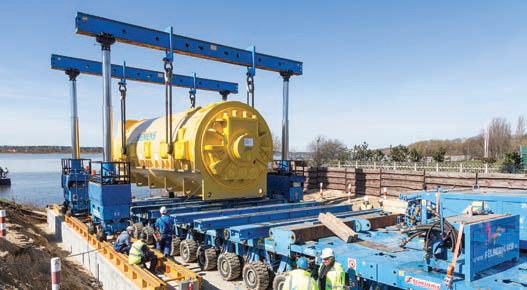Western Europe projects round up
21 June 2016This month we review projects from Manchester, Netherlands, Poland, Italy.
Manchester, UK
Ainscough Crane Hire has provided a major boost to the restoration of a Tudor hall in Manchester, which was partially destroyed by fire on March 15 in 2016.
Arsonists set the 16th century Wythenshawe Hall alight, causing severe damage to the building, which was in danger of collapsing at one point.
With a framework of scaffolding in place around the building, Ainscough used a Liebherr LTM 1100/2, fitted with a specially designed cradle, to lift the hall’s bell tower off the building.
Garry Burke, Manchester depot manager, said: “It’s amazing to think that the bell tower has been in situ for almost 500 years before we carefully lifted it off.”
Cllr Sue Murphy, deputy leader of Manchester city council, said: “A huge amount of work has already gone into helping protect Wythenshawe Hall, most visibly the scaffold cocoon that is helping to stabilise the damaged areas of the property and will support the new temporary roofing.”
Utrecht, Netherlands
Wagenborg won the ESTA awards for trailer loads over 120t, for a bridge transport project
Last summer Wagenborg transported the special bridge deck of the Kruisvaartbrug in one piece from the fabrication yard in Rotterdam to the construction site in Utrecht. In order to transport a composite bridge module, measuring 14 x 23m and weighing 45t throughout the city centre, Wagenborg engineers used a specially designed support construction to carry the bridge section in upright position, avoiding damage to trees and street furniture along the route.
Warsaw, Poland
Felbermayr developed a trimodal logistics plan, combining road, rail, and barge, to transport components weighing up to 500t for a power station in Poland.
A new combined cycle gas turbine power plant is being built for PKN Orlen northwest of Warsaw. Components for the project needed to be transported from five different locations, travelling up to 5,000km.
“The K-turbine, generator and turbine rotor and two housing parts came from the Siemens factory in Mülheim, North Rhine-Westphalia”, says Boris Albl from Felbermayr at Nuremberg. At the early stages of the project, the company needed to make some changes due to flooding. With a total weight of around 900t, the components could not be put on a coaster at Mülheim as planned, but had to be transported by barge to Nordenham at the mouth of the Weser river to the North Sea.
The gas turbine temporarily stored in Nordenham was placed with the exhaust diffuser to transport the components from Mecklenburg and Pomeranian Bay to the next reloading point.
Due to the delays the shipyard crane was no longer available. This is why the voyage continued on the Vistula estuary up to Gdansk. A 600t floating crane from Bremerhaven needed to be ordered because there was no cargo handling equipment available to load the heavyweight high-tech components.
Thus, the components could still be transshipped onto waiting pontoons on schedule.
Rolling into further obstacles, the company had to face another challenge with the permanent undercutting of the unloading platform by the river, which didn’t meet the static requirements.
The solution was the use of four pile systems that reach 10m underground in addition to placing two concrete foundations to the left and right of the ramp.
A rail mounted lifting frame was positioned on this ramp. “This enabled us to safely transfer two 500t components, after being transported from the ship by hydraulic displacement tracks. Subsequently, the gas turbine and generator were transshipped onto a 1000t Krefeld self-propelled modular transporter by a lifting frame,” explains Albl.
Before reaching the parking area, there was another serious challenge, a low-lying pipe bridge in the way of the entire 7m high load. The cargo was transported under the pipe bridge, using the rail mounted lifting frame once more. The transport team had more favorable conditions at another pipe bridge. “We were able to continue without employing extensive technical measures, the SPMT was hydraulically lowered to its lowest possible ride height of 1.2m,” says Albl. The remaining components were reloaded thanks to two 500t mobile cranes. The SPMT was reduced to eight-axle lines and that was suf_ cient to deal with the maximal 133t weights. The temporarily stored components will be moved into the machine building from mid-May.
Milan, Italy
The Cooperativa Muratori e Braccianti di Carpi (CMB), an Italian contractor, chose two Potain tower cranes to build the Hadid Tower, designed by the “Queen of the curve” Zaha Hadid.
The Hadid tower, also known as twisting tower, was born from her desire of dynamism, moving away from the concept of towers being “technocratic engineering solutions”.
This 44-floor tower is part of a triad, called “Square of three towers”, included in the Milan’s CityLife project. This represents an ambitious commercial and residential development on Milan’s historic former trade fair grounds: the Fiera Milano.
The two MDT 308A cranes were erected in December 2014, climbing at a rate of 4m per month and they are set to reach their final working heights of 210 m in 2016.



